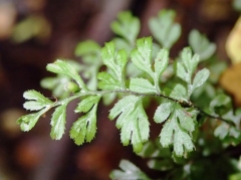Filmy Ferns are a feature of the wet gullies and rainforests in Tarra Bulga, they are usually found as epiphytes growing on the trunks of trees and other ferns, especially Soft tree-fern (Dicksonia antarctica) as well as rocks and steep embankments . There are five different species known to occur in the park and although they are small and delicate, with a bit of practice it is easy enough to learn to tell the difference between each species. Four of them belong to the same genus (Hymenophyllum). Along with the Filmy ferns there are many species of Mosses and Liverworts that flourish in similar moist sheltered locations.
Click on the Galleries for Closer Views and Photo Descriptions
Austral Filmy-fern Hymenophyllum australe
This fern is dark green and not particularly shiny. It is common and easy to identify by the wing which is several millimetres wide and extends all the way along the central wiry stem from the tip of the frond to the base (stipe) where it is attached. It has lots of spore producing sori at the tips of the fronds. The sori have 2 lips and they often present in pairs.
Shiny Filmy-fern Hymenophyllum flabellatum
This is another very common fern found in the rainforest gullies. As indicated by its common name it is very shiny and it is a lighter green than the Austral Filmy-fern. The stem (stipe) does not have a wing and has a tuft of hairs at the base. The pinnae (ends of the fronds) often form a fan shape. The sori (spore producing bits) at the tips of the frond segments are wider than the rest of the leaf.
Common Filmy-fern – Hymenophyllum cupressiforme
Common Filmy-fern is easily found and identified by serrated margins of its outer fronds. It has large spore producing sori which are located close to the main stem (rachis) of the frond. Alpine Filmy-fern (Hymenophyllum pelatum) also has serrated margins of it frond segments (pinnae) but it has never been found in the Tarra Bulga.
Narrow Filmy-fern – Hymenophyllum rarum
As its Latin name suggests this fern is the hardest to find of all the local species. It will often grow among Common – Filmy fern (e.g. Along the East-West track in the Tarra Valley picnic area) and superficially looks similar. As its common name suggests it is narrow, It has a narrow wing along its main stem which may cause confusion with Austral Filmy-fern, but a clear distinguishing feature is the the V shape made by the veins at the base of the indusium (tissue protecting the spores) at the tips of fertile frond segments. Click on the Gallery below for a better view.
Veined Bristle-fern – Polyphlebium venosum
Is the only species of the 5 ferns not in the genus Hymenophyllum. It is very common in the same habitats as the other occur. It is distinguished by its very delicate pale green shiny fronds (only one cell thick). Tiny branched veins are clearly visible on the narrow fronds. The fertile fronds have a trumpet shaped spore cover (indusium).















































